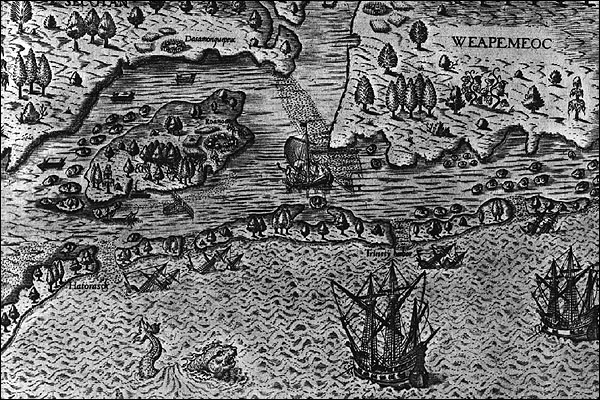One of the main reasons all of these new colonies were created in North America was over religion, as in the case of the Pilgrims and the Puritans. The three different regions had different religious influences, but it was still one of the core parts of the colonization. Similarly in all of the regions, as time went on, there began to be a decline in religious favor, though. Also, the settlers were curious to start society in a new place and to expand as much as they could with their abundant land they had found in this new territory and to in a sense "spread their wings" from England. They didn't necessarily want to seperate from England, but just become more adventurous. The three different regions had different ways of going about this though, beginning with the first colonies in the southern region.
The first region to be colonized was the South ("Slave Law..."). Jamestown, Virginia was the first British North American settlement in 1607 ("Slave Law..."). The present day states included Virginia, Maryland, and both of the Carolinas. The main factors that shaped the economy in the south were cash crops such as tobacco, rice and indigo. These crops were abundant in the region and were sold for heavy profits. These cash crops required a lot of labor, and in order to accomplish all of the work, the colonists brought in slaves, which first arrived from Africa in 1609 ("Slave Law..."). The region was defined by slavery, and was mainly settled by single men and not families. The South also did not have as good of relationships with the Native Americans as the other regions.

While the south relied on cash crops and slavery, the Northern/New England colonies utilized subsistence farming, maritime industries such as shipbuilding and fishing, and trade in livestock and timber. The region also had a lot of Pilgrim and Puritan influence. The only difference between the two groups was that the Pilgrims were seperatists from the English church and the Puritans were not. One classmate in an earlier lecture said, "The Puritans believed that they could purify the church." There were few slaves, especially compared to the South. This region was shaped more by whole familes rather than single males. The Northern colonies (Current-day Massachusetts, Rhode Island, New Hampshire, and Connecticut) were the the least diverse and had mostly an English population. This is in direct contrast to the third and final region, the Middle Colonies.

The Middle colonies were made up of present-day New York, New Jersey, Pennslyvania and Delaware. This was the most diverse colony because it was settled by several different nationalities, such as the Dutch, Germans, and obviously English. Since the colony was so diverse, it led to more religious tolerance and acceptance ("The Middle Colonies"). There was a large Quaker influence in the region, which is a religious group that believed in peace and no social class distinctions. The main crop was wheat, as flour made up 75% of the regions' exports. There was a pretty high standard of living so they enjoyed a wide range of imports. There was not a huge emphasis on cash crops overall, though, as subsistence farming played a somewhat larger role("The Middle Colonies").
The thre different British Colonial Regions in North America all seemed to be pretty different when looking in from the outside with all of their different economic and social factors. However, on the inside, they had a lot of the same core goals and reasons for colonizing, which included religious toleration and blazing their own trail away from England.
"The Middle Colonies." The Middle Colonies. N.p., n.d. Web. 12 Feb. 2013.
"Slave Law in Colonial Virginia: A Timeline." N.p., n.d. Web. 10 Feb. 2013.
how did each of the three colonial regions benefit from slavery
ReplyDeleteWHY is there a northern region????????
ReplyDeleteoof ss
ReplyDeleteHow were they all similar?
ReplyDeleteJuju guy
ReplyDeletewwwwwwwwwwwwwwwwwwwwwwwwhoooooooooooooooooooooooooooooooooooooooooooooooooooooooooooooooooooooooooooooooooooooooooooooooooooooooooooooooooooooooooooooooooooooooooooooooooooooooo
ReplyDeletei just want to know the differences and similarities between the colonial life and the 21st century life and I'm not finding anything!!
ReplyDelete